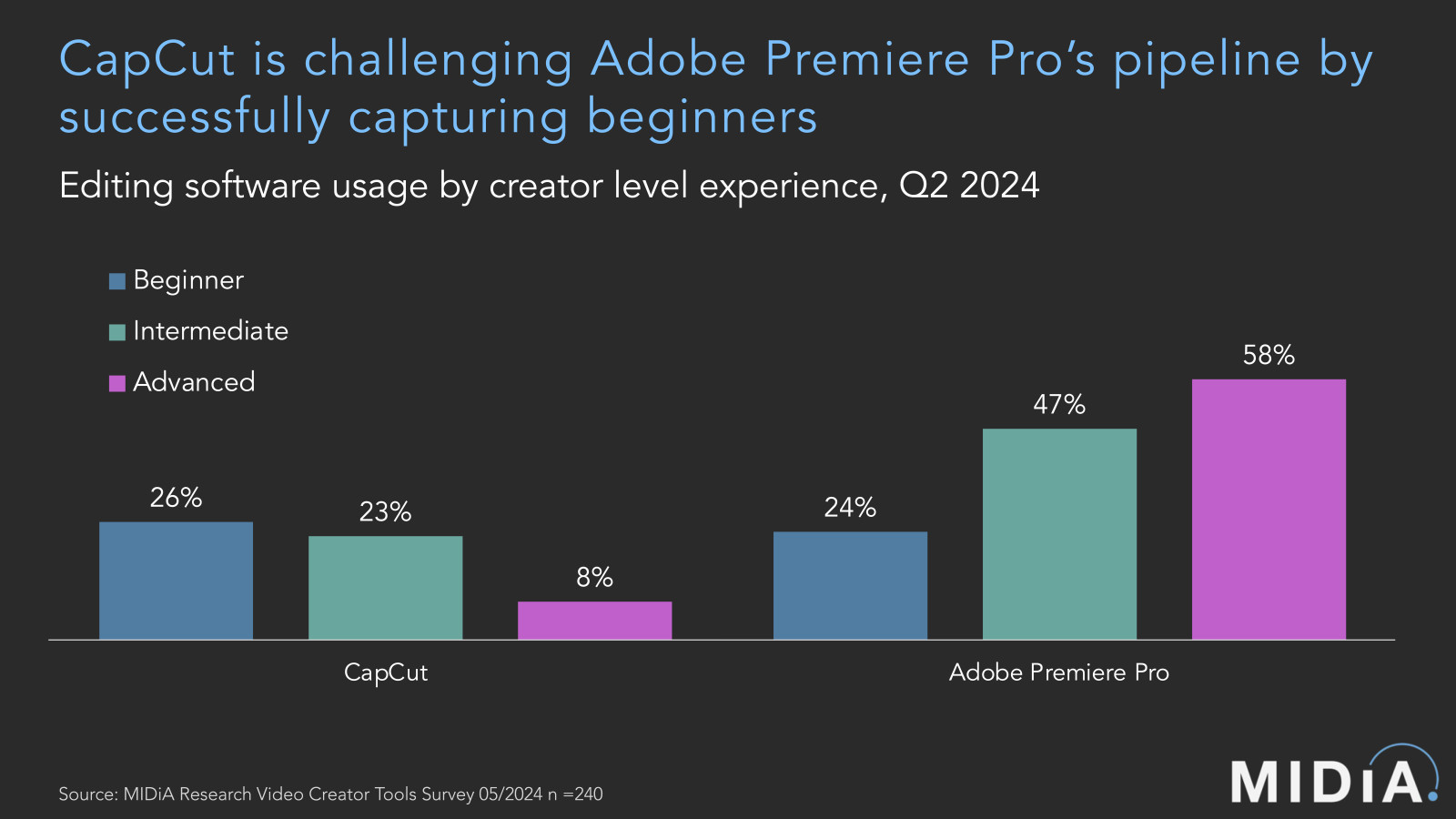How CapCut is challenging Adobe Premiere Pro’s dominance of the video editing market

Photo: MIDiA Research

Social platforms have brought a significant number of new creators into the market. With this has come a whole host of creator tools companies looking to capitalise on the opportunity. While their features may vary, they share a common goal: each app wants to secure steady, long-term engagement as a user progresses from a beginner to an advanced creator. The reason for this is simple: the longer a creator stays on platform, the greater the chance of being able to monetise that engagement while minimising churn.
The problem video editing software companies face is fragmentation. This influx of social video creators has created a larger but more complex userbase. Alongside those looking to churn out quick videos for TikTok and Instagram are the more technically focused video creators who have spent years learning the intricate tools on editing platforms largely targeted at advanced and professional creators.
The holy grail is providing a wholistic suite of apps and tools that cater to all needs. Or, even better, a suite of tools underpinned by inspirational and educational guides that encourage creators to go deeper into a platform and become experts in how they work. While the goal for video editing apps should always be to empower creators to achieve their vision with the most compelling tools possible, they also want to stop creators leaving. Creating a platform where creators must master tools to achieve distinctive results makes those users more dependent. This is partly because the more embedded a creator’s workflow becomes within a platform, the more aggravating it is to shift their allegiance. It would mean taking the time to learn new interfaces and shortcuts to make their workflows as efficient as before.
Securing long-term engagement
So how do companies manage the video creator journey so that users become more embedded as their experience grows? Adobe Premiere Pro and CapCut are grappling with this question, but for different reasons. Adobe Premiere Pro has strong penetration among intermediate and advanced creators at 47% and 58% respectively, according to MIDiA’s Q2 2024 video creator survey. However, it is being challenged by CapCut when it comes to beginners: 24% of beginners use Adobe Premiere Pro and 26% use CapCut. Conversely, CapCut is weaker than Adobe Premiere Pro when it comes to capturing intermediate and advanced level creators ––23% and 8% respectively. Bolstering these weaker areas is how Adobe Premiere Pro and CapCut can take a step towards securing a steady pipeline of new creators that can be transformed into long-term users.
One way to do this would be to try and replicate each other’s strengths. However, their differing strategies and relationships makes this tricky. CapCut has a powerful user acquisition funnel driven by TikTok, the short-form video platform. TikTok consumers wanting to create their own videos are directed towards CapCut. Meanwhile, TikTok videos using CapCut templates carry a watermark that links directly to the CapCut app. Through their collective ByteDance ownership, TikTok and CapCut have created a virtuous circle between consumption, creation, and distribution, which funnels TikTok users towards CapCut.
Featured Report
The audio creator opportunity Audio creator behaviours and monetisation potential
Historically, YouTubers and TikTok influencers have received the lion’s share of mainstream attention as a creator class – but audio creators are increasingly active on the same digital platforms and operating within the same formats. As a result, the audio creator has become a jack of all trades, moving between copyediting, audio editing, and ...
Find out more…However, this freemium model becomes challenging when monetising these creators. CapCut began by offering pro-level features for free to give new users a compelling reason to keep creating on the platform. However, many of these features have now been moved behind its paywalled CapCut Pro service priced at £13.99 a month. This is a steep jump for CapCut users brought up on a diet of free creation tools.
Meanwhile, CapCut’s convenience could also be its Achilles heel. CapCut’s Pro tools do much of the heavy lifting for the creator, meaning they do not need to master these processes as part of their workflow. This is powerful for helping beginners achieve video output beyond their skill but may prove too shallow for advanced creators who want a surgical approach. If a video creator does not have to invest time mastering a tool, then it is less annoying to move to another editing platform.
The question here is whether convenience is better at driving sustained engagement than tools offering higher creative control that take more time to master them. For social media creators chasing engagement fast, the former may prove more powerful. For experienced video creators honing their craft in pursuit of distinct content, the latter may prove more attractive.
When it comes to Adobe Premiere, however, the challenges are almost opposite to CapCut. The years spent catering to the demands of professional video creators has put its video editing software in a dominant position among intermediate and advanced creators. These creators are willing to pay a £32.98 subscription fee (more than double the cost of CapCut Pro) for a vast array of creation tools that offer precision control.
While it clearly knows how to serve this end of the market, the danger is that CapCut and other video editing rivals such as Canva divert the pipeline of beginners towards their services. This could make those users harder to acquire when they become more experienced. Adobe Premiere Pro has responded with the launch of paired down, social media focused apps aimed at beginners, such as Adobe Express and Adobe Premiere Rush. However, both services must rely on users seeking them out, rather than discovering them through content consumption process as users do on TikTok with CapCut.
Narrowing the gap between creation, consumption and distribution
Exploring partnerships with social media platforms that allow a closer relationship between Adobe’s tools for content creation and the distribution and consumption of content is an option for Adobe. After all, it is already exploring ways of containing the threat posed by third-party generative AI platforms by striking a partnership with OpenAI’s Sora. Sora challenges Adobe Premiere Pro by streamlining significant portions of the video production process.
What CapCut has taught the video editing market is that new users are receptive to a symbiotic experience that closely aligns content consumption with content creation. However, as video creators develop, the need for surgical-level tools that empower creative control remains strong. In the battle between CapCut and Adobe Premiere Pro, it may come down to who is savvy enough to adopt the other’s strength’s first.
- Click here for more information on MIDiA’s new “The state of the video creator economy” report

The discussion around this post has not yet got started, be the first to add an opinion.